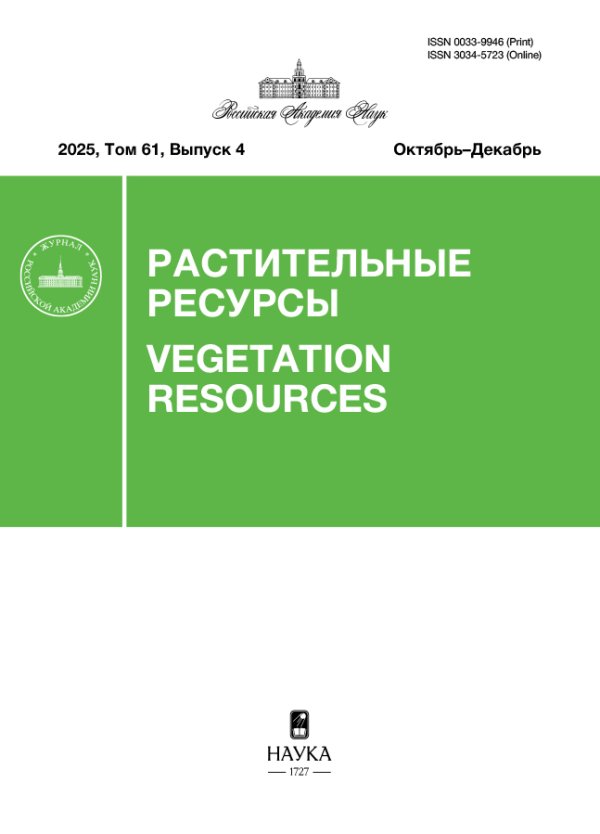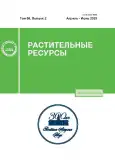Effect of Urban Environment on Ecological and Phytochemical Features of Crataegus fallacina (Rosaceae) Flowers (the Case of the Donbass)
- Authors: Vinogradova N.A.1, Glukhov A.Z.2
-
Affiliations:
- M. Gorky Donetsk National Medical University
- Donetsk Botanical Garden
- Issue: Vol 59, No 2 (2023)
- Pages: 180-188
- Section: АНТРОПОГЕННОЕ ВОЗДЕЙСТВИЕ НА РАСТИТЕЛЬНЫЕ РЕСУРСЫ
- URL: https://journals.rcsi.science/0033-9946/article/view/138786
- DOI: https://doi.org/10.31857/S0033994623020115
- EDN: https://elibrary.ru/ZNQIKB
- ID: 138786
Cite item
Full Text
Abstract
Abstract
—The article presents the results of a study of the effect of urban environment in the Donbass on the content of biologically active substances, heavy metals and antioxidant activity of the flowers of Crataegus fallacina Klok., a poorly studied non-pharmacopoeial species of the genus Crataegus L. Under technogenic pollution, in the flowers of C. fallacina a decrease in the concentration of carotenoids and an increase in the content of phenolic compounds (flavonoids, procyanidins, oxycinnamic acids, tannins, anthocyanins), ascorbic and free organic acids was detected. The hermetic response of the content of anthocyanins and procyanidins to the pollution level was observed. The flowers of C. fallacina have a high total antioxidant activity, which increases under technogenic load, indicating plants sufficient adaptation to the urbanized environment. The ability of C. fallacina plants to limit flow of cadmium and lead to generative organs was revealed. The concentration of mercury in flowers exceeds its concentration in soil. C. fallacina flowers harvested in the Donbass meet the regulations on the content of active substances and comply with the requirements with regard to the heavy metals content. The obtained results prove the practicability of using C. fallacina for pharmaceutical purposes along with pharmacopoeial species of the genus Crataegus, and the possibility of their harvesting for medicinal use in the Donbass.
About the authors
N. A. Vinogradova
M. Gorky Donetsk National Medical University
Author for correspondence.
Email: arina0vinogradova@yandex.com
Russia, Donetsk
A. Z. Glukhov
Donetsk Botanical Garden
Email: arina0vinogradova@yandex.com
Russia, Donetsk
References
- World Health Organization. Cardiovascular diseases (CVDs). https://www.who.int/news-room/fact-sheets/detail/cardiovascular-diseases-(cvds)
- Orhan I.E. 2018. Phytochemical and pharmacological activity profile of Crataegus oxyacantha L. (hawthorn) – a cardiotonic herb. – Curr. Med. Chem. 25(37): 4854–4865. https://doi.org/10.2174/0929867323666160919095519
- Kumar D., Thakur K., Sharma S., Kumar S. 2019. NMR for metabolomics studies of Crataegus rhipidophylla Gand. – Anal. Bioanal. Chem. 411(10): 2149–2159. https://doi.org/10.1007/s00216-019-01646-z
- Moustafa A.A., Zaghlou M.S., Mansour S.R., Alotaibi M. 2019. Conservation strategy for protecting Crataegus x sinaica against climate change and anthropologic activities in South Sinai Mountains, Egypt. – Catrina: The International Journal of Environmental Sciences. 18(1): 1–6. https://doi.org/10.12608/CAT.2019.28577
- Venskutonis P.R. 2018. Phytochemical composition and bioactivities of hawthorn (Crataegus spp.): review of recent research advances. – J. Food Bioact. 4: 69–87. https://doi.org/10.31665/JFB.2018.4163
- Yahyaoui A., Arfaoui M.О., Rigane G., Hkir A., Amari K., Salem R.B., Ammari Y. 2019. Investigation on the chemical composition and antioxidant capacity of extracts from Crataegus azarolus L.: effect of growing location of an important Tunisian medicinal plant. – Chemistry Africa. 2(3): 361–365. https://doi.org/10.1007/s42250-019-00054-1
- Goncharov N.F. 2008. Studying of essence flowers North American kinds of hawthorns. – Kuban Scientific Medical Bulletin. 5(104): 52–55. https://www.elibrary.ru/item.asp?id=12364957 (In Russian)
- Kozaeva M.I. 2014. Adaptive capacity of different species of Crataegus and Amelanchier under abiotic and biotic stresses. – Austrian J.Technical and Natural Sciences. 7–8: 84–85. https://ppublishing.org/media/uploads/journals/journal/AJT_7-8_2014.pdf (In Russian)
- Shubina T.V., Gainetdinova A.A., Khismatullina A.A., Gusakova V.A., Khasanova S.R., Kudashkina N.V. 2021. Study of saponin content in various species of the genus Crataegus L. – In: [90 years – from plant to drug: achievements and prospects. Proc. of intern. sci. conf.]. Moscow. 499–501. https://doi.org/10.52101/9785870191003_2021_499 (In Russian)
- [The State Pharmacopoeia of the Russian Federation XIV]. 2018. V. 4. Moscow. 1883 p. https://femb.ru/record/pharmacopea14 (In Russian)
- Ostapko V.M., Prikhodko S.A., Mulenkova E.G. 2019. [Ephedra distachya L. in the flora of the Donbass]. – Novosti nauki v APK. 1–2(12): 36–40. https://doi.org/10.25930/gqbg-ss60 (In Russian)
- Lysenko G.N., Yarovy S.S. 2019. The dynamics of vegetation cover of petrophytic (on granites) steppes of “Kamennye Mohyly” (Donetsk region, Ukraine) under the influence of the absolute reserve regime. – Steppe Science. XV: 189–191. https://doi.org/10.24411/9999-006A-2019-11529 (In Russian)
- European pharmacopoeia. 10th ed. 1. 2019. Strasbourg. 4370 p.
- Vinogradova N.A., Glukhov A.Z. 2021. Ecological and phytochemical features of Crataegus fallacina Klokov under conditions of technogenic pollution. – Contemp. Probl. Ecol. 14(1): 90–97. https://doi.org/10.1134/S1995425521010091
- Pasqualini V., Robles C., Garzino S., Greff S., Bousquet-Melou A., Bonin G. 2003. Phenolic compounds content in Pinus halepensis Mill. needles: a bioindicator of air pollution. – Chemosphere. 52(1): 239–248. https://doi.org/10.1016/S0045-6535(03)00268-6
- Sandre A.A., Pina J.M., Moraes R.M., Furlan C.M. 2014. Anthocyanins and tannins: is the urban air pollution an elicitor factor? – Braz. J. Bot. 37(1): 9–18. https://doi.org/10.1007/s40415-013-0043-0
- Chupakhina G.N., Maslennikov P.V., Skrypnik L.N., Chupakhina N.Y., Feduraev P.V. 2016. [Antioxidant properties of cultivated plants of the Kaliningrad region: monograph]. Kaliningrad. 145 p. (In Russian)
- Azzazy M.F. 2019. Plant bioindicators of pollution in Sadat City, Western Nile Delta, Egypt. – PLoS One. 15(3): e0226315. https://doi.org/10.1371/journal.pone.0226315
- Nihal A., Mithun P.R., Praveen N. 2019. Effect of heavy metals (Hg, As and La) on biochemical constituents of Spinacia oleracea. – J. Pharmacogn. Phytochem. 8(3): 669–674. https://www.phytojournal.com/archives/2019/vol8issue3/PartM/8-3-72-162.pdf
- [The State Pharmacopoeia of the Russian Federation XIV]. 2018. V. 2. Moscow. 1449 p. https://femb.ru/record/pharmacopea14 (In Russian)
- Tarabrin V.P., Kondratyuk E.N., Bashkatov V.G., Ignatenko A.A., Korshikov I.I., Chernysheva L.V., Shatskaya R.M. [Phytotoxicity of organic and inorganic pollutants]. 1986. Kyiv. 215 p. (In Russian)
- Kurkin V.A., Morozova T.V., Pravdivtseva O.E. 2017. [Studies on the development of a methodology for standardization of leaves of Crataegus sanguinea Pall.] – Khimija rastitel’nogo syr’ja. 3: 169–173. https://doi.org/10.14258/jcprm.2017031286 (In Russian)
- [The State Pharmacopoeia of the Republic of Belarus I]. 2007. V. 2. Molodechno. 471 p. (In Russian)
- Khishova O.M., Buzuk G.N. 2006. Quantitative determination of procyanidins in hawthorn fruits. – Khimiko-farmatsevticheskii zhurnal. 40(2): 20–21. http://chem.folium.ru/index.php/chem/article/view/1819 (In Russian)
- Khasanova S.R., Plekhanova T.I., Gashimova D.T., Galiakhmetova E.K., Klysh E.A. 2007. [Comparative study of antioxidant activity of herbal mixtures]. – Proceedings of Voronezh State University. Series: Chemistry. Biology. Pharmacy. 1: 163–166. http://www.vestnik.vsu.ru/pdf/chembio/2007/01/2007-01-33.pdf (In Russian)
- [Guidelines for the determination of heavy metals in agricultural soils and crop production]. Approved 03.10.1992. 62 p. (In Russian)
- [SanPiN 1.2.3685-21. Hygienic standards and requirements for ensuring the safety and (or) security of environmental factors for humans]. Approved on 01.05.2021. 988 p. (In Russian)
- Perel’man A.I. [Geochemistry of the landscape]. 1975. Moscow. 342 p. (In Russian)
- Calabrese E.J., Blain R.B. 2009. Hormesis and plant biology. – Environ. Pollut. 157(1): 42–48. https://doi.org/10.1016/j.envpol.2008.07.028
- Nemereshina O.N., Gusev N.F. 2004. [The effect of technogenic pollution on the content of flavonoids in plants of the Scrophulariaceae family of the steppe Urals.]. – Vestnik Orenburgskogo gosudarstvennogo universiteta. 10(35): 123–126. https://elibrary.ru/item.asp?id=11528939 (In Russian)
- Ali M.A., Fahad S., Haider I., Ahmed N. Ahmad S., Hussain S., Arshad M. 2019. Oxidative stress and antioxidant defense in plants exposed to metal / metalloid toxicity. – In: Reactive Oxygen, Nitrogen and Sulfur Species in Plants: Production, Metabolism, Signaling and Defense Mechanisms. P. 353–370. https://doi.org/10.1002/9781119468677.ch15
Supplementary files










